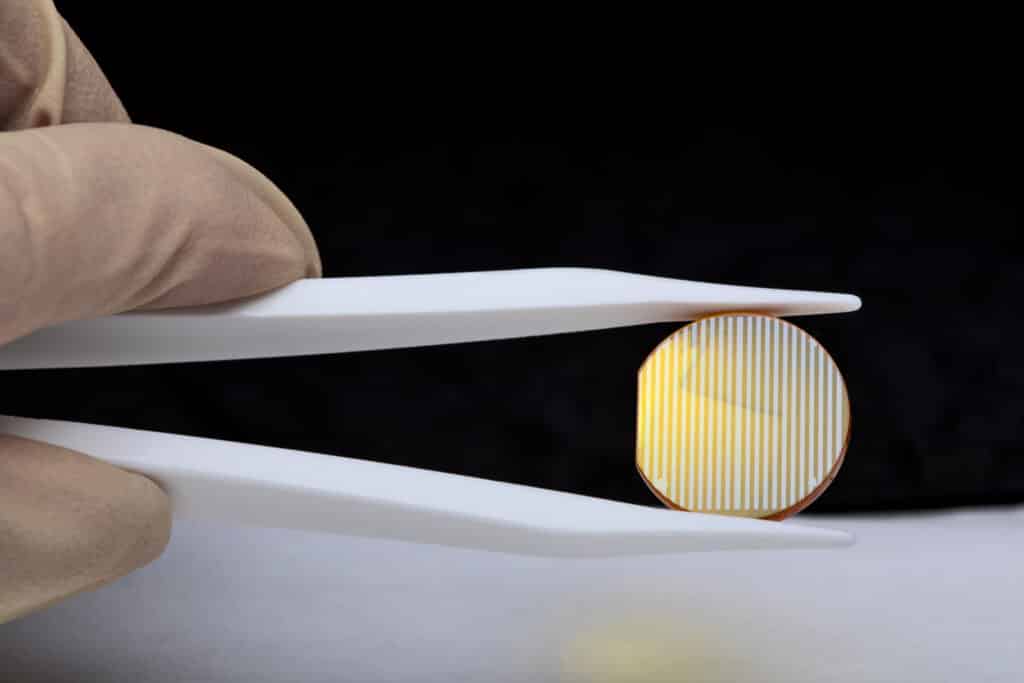Introduction: Custom Diffraction gratings - theory
Diffraction gratings are some of the most well-known diffractive optical elements and are used in countless laser applications. A simple diffractive grating is any surface that has a periodic modulation in intensity or phase. Such modulation creates a diffraction effect on coherent light going through the grating, resulting in the splitting of the input beam into multiple out beams, called orders.
The relationship between the angles of the order, the order number and the period is known as the grating equation. For small angles (large grating period vs the wavelength of incoming light), the orders have a linear separation, enabling generation of precise spot separations if the beams are focused by a lens.

While simple binary diffractive gratings often have most energy in the first two orders (+-1), more complex periodic gratings can generate energy distributions that allocate most of the input laser energy equally to a desired number of output orders. These are often called Damman gratings or Fan out gratings. By creating surface structures that are periodic in both x and y, i.e made of cells that are replicated over the entire surface, custom diffraction gratings can also split the light to two-dimensional beam arrays.
Design of Custom diffractive gratings
Diffraction grating are optimized to a single wavelength, with a bandwidth of +-2% (typically) around it, by defining the grating depth according to the design wavelength. The first stage of designing a custom diffraction grating is the definitions: specs such as the laser wavelength , number of desired orders and the fan out angles must be defined. Following this, the grating period is calculated using Holo/Or’s grating optical calculator. Using the period and the other specs, the phase structure is then designed using a modified Gershberg-Saxton algorithm that has as a Target the desired order distribution. The custom diffraction grating design is then manufactured in a method similar to other diffractive optical elements.
How does Holo/or manufactures diffractive optical elements?
Diffractive optical elements are produced at Holo/oOr using semi conductor based methods. In the production process, the DOE design is converted to binary phase steps. Each step is written using a direct laser writer on a fused silica or ZnSe window coated with photoresist. The resist exposed to UV light is then removed by development, leaving the structured of the diffractive optical design. Next, a dry etching process is used to etch the open glass areas to a precise depth corresponding to the necessary phase delay for the DOE design wavelength. Afterwards, the window is cleaned of photoresist and AR coated, resulting in a monolithic, high LDT window with a diffractive optical surface as designed. Holo/Or’s production method has an advantage in terms of almost absolute angular accuracy of the resulting DOE, since the tolerances on the period of the diffractive structures is effectively negligible.
Applications of custom diffraction gratings
Custom diffraction gratings find many applications in the laser industry. In aesthetics, custom 2D gratings are used in fractional laser skin treatments. In industrial applications such as semiconductor production, microelectronics and solar cell production custom diffraction gratings enable parallel ablation of multiple channels, increasing throughput. Finally, in metrology, spectroscopy and other instrumentation applications, custom diffraction gratings are useful for sensing over several samplers and in defining precise distances.
Conclusion
Custom diffraction gratings are versatile optical elements that split an input beam into any array of output beams with pre-designed ratios of power between them. Often, equal power is the most useful for many applications. Custom Diffraction gratings are designed by digital iterative processes based on the desired performance, and produced using semiconductor methods, resulting in very high accuracy. These custom DOE are useful in many laser applications, from medical aesthetic, through material processing to sensing and metrology.
TL;DR:
What are Custom Diffraction gratings?
Custom diffraction gratings, also called multi-spot DOE, are diffractive components that split an input beam into many output beams with predetermined angles. Unlike standard diffraction gratings, any orders can receive energy equal, not only the first orders.
How are Custom diffraction gratings designed?
The design is based on the needed splitting parameters (number of beams, angular separation and wavelength). These parameters are used to calculate the period, and with the period an iterative algorithm designs the necessary phase profile to achieve the desired fan-out performance.
How are DOE, including diffraction gratings, produced?
DOE are produced by using semiconductor methods to write the desired phase topography in photoresist and then etch it into the bulk of the glass or ZnSe window.
What are the common applications of custom diffraction grating in the laser industry?
The common applications are medical aesthetic laser treatments, material processing and sensing/ metrology.

